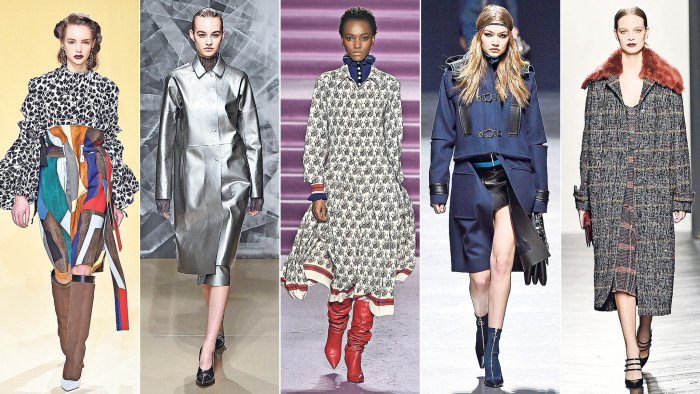In Milan, the fashion ‘dream’ lives on

Simply sign up to the Life & Arts myFT Digest -- delivered directly to your inbox.
The weekend started with a boob. Gigi Hadid’s boob, to be precise, which popped out of her sequinned cocktail gown at the close of the Versace show.
Wardrobe malfunction? Apparently yes, and Donatella, who had booked the model to walk for her exclusively in Milan, insisted she was mortified by its appearance. Hadid now has 14m Instagram followers, and was joined by Kendall Jenner, who has 50m, on possibly the longest catwalk of the month. Her embonpoint has since been politely erased from the coverage, but next time an earlier fitting might be required. Booking a social media star brings its own unique sartorial complications.
Ms Versace’s AW16 “urban” wardrobe ran the gamut, from navy duffel coats to sky blue leathers, patent panelled leggings, with a kick-flare, and plasticky pastel bonded leather coats, and it continued a trend in Milan for day wear. Whether you plan to hit the boardroom in a sky blue asymmetric leather miniskirt and biker jacket any time soon may be moot. But the focus on wearability was woven into many collections here.
At Bottega Veneta, Tomas Maier proposed a “long and lean” silhouette, and knits that should “embrace the body” in a sober palette of dark navy, black and slate wool checks, shot with sapphire blue and glimmers of gold. At Jil Sander, mannish tailoring was cinched with asymmetric folds, corsetry and silverised mohair to make it more womanly and alluring. Rodolfo Paglialunga’s third collection was convincing, with some good clean cuts and a pleasingly severe glamour about it, although the talk afterwards was more taken up with model Lineisy Montero’s hair. Her short afro had been transformed into a slicked back ponytail, which swung between her shoulder blades. “There’s no one who can do flattening like that in Milan!” observed blogger and editor Tamu McPherson. “And believe me, I’ve looked.” (London’s own Sam McKnight had styled the show).

That there’s a new sense of energy and focus in Milan is palpable. A lot of that is due to the work of Carlo Capasa, president of the Camera Nazionale della Moda Italiana (the Italian chamber of fashion), who will celebrate his first year in the job in April. Capasa, who is chief executive of Costume National, which he founded with his brother in 1986, has spent this first year working to co-ordinate the many disparate bodies of the industry. His mandate: to nurture new, young design talent; to promote sustainability in the treatment of materials, manufacture and social welfare practices within the industry (as well as to encourage the restoration and protection of cultural landmarks utilised by big retail brands); and to systematise the various Italian fashion fairs, markets and presentation schedules that take place within its cities.
Last year was tough for luxury, with market collapse in China, foreign currency fluctuation and the Paris terror attacks, which near-paralysed sales in the French capital at the end of 2015. “Maybe it’s a condition of the Italians, that we are lazy,” said Capasa. “But we work well in a crisis. The situation has given us the impetus to do something we knew needed doing a long time ago.”
They need to act fast. According to Capasa, Italian ready-to-wear apparel and accessories accounted for an €80bn turnover in 2015, up 1.4 per cent on 2014, and is projected to rise 2.6 per cent in the year to come. If the figures included eyewear and jewellery, that turnover would be €100bn, while the Italian perfume industry would see that figure rise again.
Like many Italian luxury representatives, Capasa is dismissive of the “ready-to-buy” culture being adopted by so many brands today. “It will crush creativity,” he said. “For fashion, you have to have the ‘dream’ of the show. You need the time to co-ordinate the hundreds of small artisanal companies that need to fulfil the orders. The younger designers need the time to produce the wholesale orders on which they depend to get the loans they need to build their brands. This way, the big commodity brands will produce big, Super Bowl-style fashion shows. That will shift product but we’ll become a commodity-led market.”
A “dream” seems a flimsy concept. “But look at politics,” said Capasa. “You sell the vision and then make the smaller changes in government. The dream is not a general thing. Fashion is the largest industry in Italy after tourism, but it’s also the most contemporary form of art. Without real creativity, there can be no innovation.”
There was innovation here. On Sunday morning, Marni delivered a typically avant-garde AW16 collection of abstract prints, sculptural silhouettes and stirrup pants (never mind global warming, designers are banking on an incoming ski trend). And Philosophy was ruffly and romantic and essentially Italian. There were Super Bowl moments, too. Will I ever be able to forget the experience of attending the Philipp Plein show, staged in a cavernous, mirror-filled “nightclub”, in which three monster trucks delivered its chattel of leather-clad, fur trimmed models to stomp around in a fog of diesel fumes to the live accompaniment of Chris Brown? I really hope so.
Thank God, then, for the clean, chic perfection of Salvatore Ferragamo, a show inspired by the geometric shapes of early 1920s and 1930s modernism in a jazzy palette of colours. It’s a show that gets precious little media coverage, owing to its late Sunday scheduling, but it continues to be one of my personal favourites.
Milan Fashion Week is nearly over. It’s been a good one. Now off to Paris. And thanks for the mammary.
Photographs: Catwalking.com
Comments